Microplastics 101: In the Environment, In the Air, In your Food
Welcome to the Earthlife Web introduction to Microplastics. Microplastics are a topic you will be hearing more and more about as the future unfolds, but what are microplastics and why should we be concerned?
What Are Microplastics?
Microplastics simply means “Microscopic pieces of plastic”. However, because this is such a new area of research scientists are still discussing the exact size limits that define microplastics. Nevertheless there is consensus that the upper limit of size is 5 mm in any direction.
Some people argue, that because the size range of plastic pieces we are discussing is so great (from 5 mm down to less than 1 nm) we need more than one term, at least for scientific purposes. I would agree with this. Microplastics is already a buzzword, it will continue to be used in the media and by lay people.
A more rigorous scientific definition may be as follows.
- Mesoplastics = 5mm or 5000 microns to 1mm or 1000 microns
- Microplastics = 1mm or 1000 microns to 0.0001mm or 1 micron
- Nanoplastics = 0.0001 mm or 1 micron to 0.000001 mm or 0.001 microns
Nanoplastics, A Swelling Tide.
This article is primarily about microplastics for the good reason that more information concerning microplastics in the environment is expanding every day. Nanoplastics are a different situation. According to a review published in April 2019, of 1699 papers on microplastics only 20 looked at nanoplastics.
With so little research yet done it is difficult to say much. However, it should be obvious that as the inevitable degradation processes of environmental plastic continues the amount of nanoplastics is only going to increase.
This is a bit scary. Why? Because while microplastics are eaten and do move up the food chain, especially in marine environments, most of this plastic remains in the digestive system. Nanoplastics are different. They are small enough to cross membrane barriers. They have been recorded in haemolymph, in muscle tissue and inside cells.
Furthermore some research has shown that nanoplastics can change the way proteins function inside a living organism.
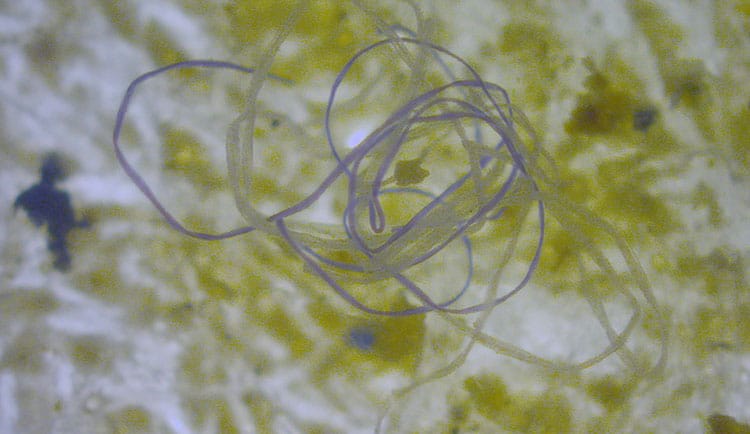
A Little Background To Plastic As Pollution.
The first scientific papers on the topic of plastic as pollution started being published in the 1970s. Microplastics first began to be discussed after 2000 and has been a topic of increasing interest ever since. ResearchGate lists more than 250 papers published on the topic in the first eight months of 2020.
Part of the problem of understanding the threat from microplastics is that plastic is not one substance. If you look at the glossary below you will see the prefix ‘poly’ occurs many times. This poly (meaning many), and the fact that plastics are synthetic (man made) is what links all the different plastics together.
Plastic is any synthetic, or semisynthetic, organic polymer. A polymer is a material made of long, repeating chains of the same, or similar molecules. The materials have unique properties, depending on the type of molecules being bonded and how they are bonded. Polymers occur naturally, cellulose, DNA, silk and wool are all natural polymers.
There are many different types of plastics. The market is currently dominated by seven main types.
- Polypropylene (PP).
- Low density polyethylene.
- (LD-PE), High density polyethylene.
- (HD-PE), Polyvinyl chloride (PVC).
- Polyurethane (PUR).
- Polyethylene terephthalate (PET).
- Polystyrene (PS).
Numerous other kinds of plastics exist. Plastics also come in various sizes, shapes, colours. Furthermore they are treated with additives (e.g. fillers, plasticizers, colourizers and stabilizers etc) to modify their properties. It is often these additives that give plastics their toxic properties.
Why Don’t Plastics Biodegrade?
Basically the answer is that the carbon-carbon bonds in plastic require too much energy to break.
Before an organism can breakdown and recycle the individual monomers that make up a polymer they need to break the momomer off the chain. In other words biological processes can only deal with molecules one at a time. The links of the molecular chains that make up plastics are too strong for them to break.
Modern plastics have these high strength carbon=carbon bonds because they are cooked using catalysts, high temperatures and high pressure. This intense focus of energy allows very strong double carbon bonds to be created. Most natural organisms do not have the energy, or the native enzymes, needed to break these bonds.
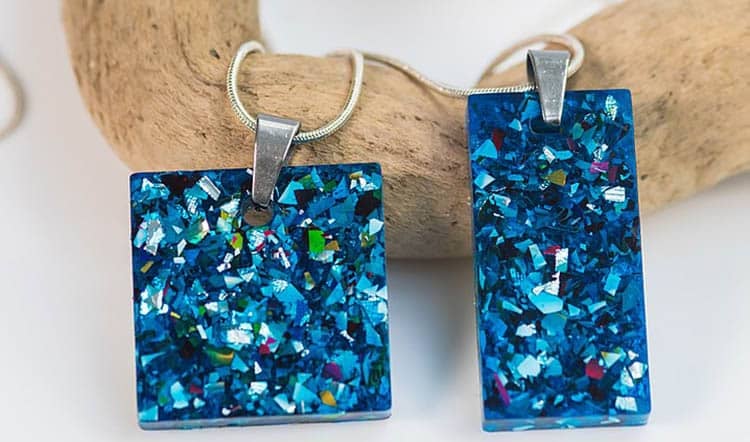
What Can Nature Really Do With Plastic?
In 2016 Japanese scientists have discovered a bacterium called Ideonella sakaiensis that can break down PET. Unfortunately the process is very slow. Far too slow and uncertain in environmental situations to currently be of much use.
It is also true that UV (ultra violet) light from the sun can break down the bonds in plastics, this is called photodegradation. Regrettably this just results in large pieces of plastic becoming smaller pieces of plastic. It does not result in the breakdown of plastic into individual monomers that microorganisms can recycle in any reasonable amount of time. For natural sources to break down a plastic cup, bottle or bag takes from 50 to 600 years depending on what type of plastic it is made from.
Biodegradable Plastics.
It should be noted that biodegradable plastics do exist. Both PHAs and PLAs are biodegradeable plastics. They are commonly used for disposable items, such as packaging, cutlery, and food service containers. Theoretically they could be used to replace many other conventional plastics. Sadly this is not happening in our world.
This is because, unfortunately, creating such plastics is more expensive than creating conventional plastics.
Which in turn means any products made from such plastics are more expensive. Their usage then is only financially favorable if supported by government regulations limiting the usage of conventional plastics. Sadly this does not happen very often.
This is because, for the most part, we live in a world where economic convenience is still considered more important than the health of our children or the environment.
The situation can be improved. A few countries are moving in the correct direction. In Italy biodegradable plastic bags and shoppers have been legally compulsory since 2011.
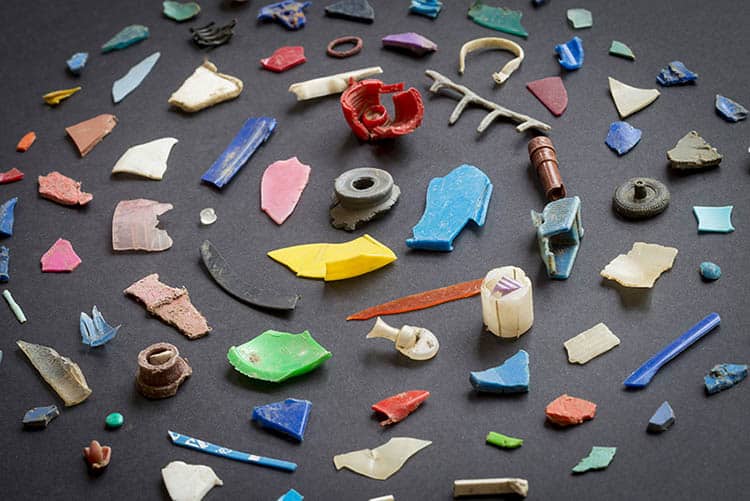
Where Do Microplastics Come From?
Microplastics all come from man made plastics. They are usually divided into two categories, primary microplastics and secondary microplastics.
Primary microplastics are microplastics that are intentionally manufactured as microplastics. Such deliberately created microplastics are used in cosmetics, shampoos and as industrial abrasives. Nurdles are a good example of primary microplastics.
Secondary microplastics are microplastics that arise from the release of minute particles of plastic from large plastic items.
Sources of such secondary microplastics include:-
- Micro-fibres from synthetic materials. These particles are released during ordinary usage and especially during cleaning.
- Microplastics from the breakdown of plastic rubbish under UV light and accidental abrasion.
- Abrasion products from car tires.
- Microparticles released into the air from paint and other surface coatings.
- Recent research has also indicated that washing clothing and towels etc. made from artificial polymers release hundreds of thousands of particles of microplastic into the water drainage system every wash.
How Much Plastic Is There?
The exact answer is probably not known and the totals given here are the minimums. However virtually every piece of plastic that was ever made still exists in some shape or form (with the exception of the small amount that has been incinerated).
A study, published in the peer-reviewed journal Science Advances in 2017, was the first global analysis of all plastics ever made — and of their fate. This study concluded that 8.3 billion metric tons (9.1 billion US tons) of plastic had been produced up to that date.
Of the 8.3 billion metric tons of plastic so far produced on this planet 6.3 billion metric tons has become plastic waste.
Horrifically only nine percent of the plastic produced worldwide has been recycled.
The vast majority, 79 percent, is accumulating in landfills or breaking up into microplastics in the natural environment somewhere or else still in use. A whopping 91% of plastic isn’t ever recycled.
Despite the numerous scientific alarm bells being sounded plastic production continues to increase. Global plastic production rose from 322 million metric tons in 2015 to 359 million metric tons in 2018.
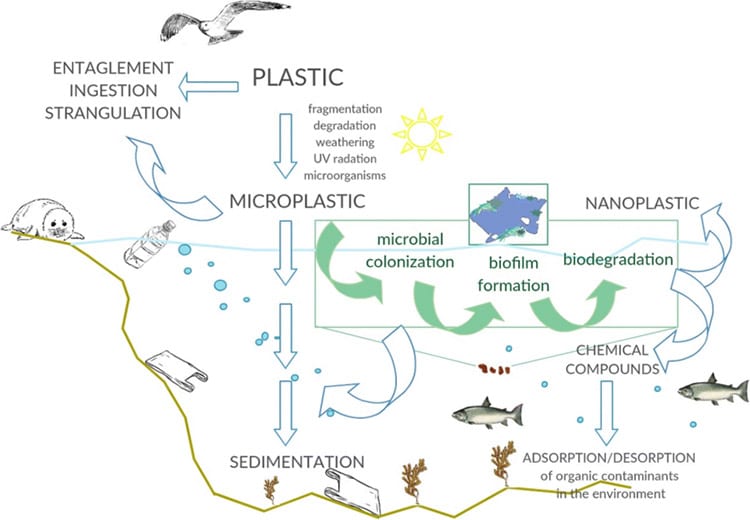
The Plastic Cycle
Pieces of plastic are not nailed to the surface of the earth, though many may become lodged in certain places for a long time.
Ultimately plastic is a very mobile pollutant.
Plastic travels easily in both the air and in water. This is especially so as the pieces of plastic become smaller and smaller. It is true that natural water flow persistently moves huge amounts of plastic towards the oceans and eventually in to the ocean gyres.
However once marine microplastics have become small enough to be picked up by the wind again they can end up anywhere. Microplastics move all around the planet. Microplastic has been found in the soils of high mountains, remote valleys and uninhabited deserts.
Because of this mobility, and because the physical spade and size of plastic pieces is constantly being changed and also because plastics interact with the biological components of the environment as well as the non-biological, scientists now talk about “The Plastic Cycle” in much the same way they talk about the Carbon Cycle or the Water Cycle.
As part of the modern study of the Plastic, and particularly the Microplastic Cycle a group of researchers in the USA were recently (the paper was published in June 2020) shocked to discover that thousands of tons of microplastics are being deposited all over the USA every year. Microplastics were found in both rain water and in dry deposition in all of the protected areas surveyed in the study. The amount of microplastics falling to the ground, in even the remotest areas, and what this means for the future of our plastic obsessed society, are simply scary. Until recently nobody appreciated the ease with which microplastic particles travel around the world.
Why Are Microplastics a Problem?
There are a number of reasons why we, the human race, should be concerned about the ever increasing soup of microplastics that surrounds us. Science has shown in numerous tests over the last couple of decades that microplastics enter the food chain at the level of zooplankton and filter feeding aquatic animals.
From this lowly level they multiply up exponentially, as do all pollutants, as you follow them up the food chain. The higher up an animal is in the food chain the more microplastics it accumulates per kilogram of food. We human beings are at the top of the food chain, which makes us vulnerable to whatever effects microplastics have on our bodies.
Scientists now know that microplastics can cross membrane barriers and become embedded in animal tissue. Once embedded they can have physical irritation effects which impact health. This becomes even more important when we think about the toxicological effects. Both from the plastics themselves, and from other chemicals they may acquire through sorption.
No living creatures evolved to eat plastics. Not zooplankton, not shrimps and clams and certainly not us. It is believed that the negative effects of microplastics in a biological system will be cumulative and long term. As of yet we are just at the beginning of the microplastic pandemic.
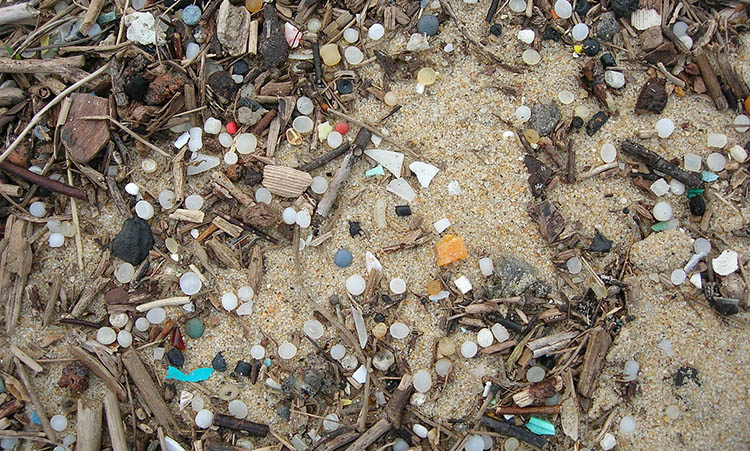
The Problem of Sorption
Sorption is the process whereby pollutant and other chemicals adhere to, or become embedded in plastic, especially microplastics. Our environment is subject to a large number of chemical pollutants.
These arise from agricultural practices and from the anthropocentric environment. Excess pesticides, herbicides and other –cides are well know water contaminates. Other complex chemicals include antibiotics and hormones used in animal husbandry. Finally other chemicals and hazardous ions accrue from mining and industrial processes.
To varying degrees around the world these harmful chemicals end up in the environment. Most notably fresh water and marine habitats, but also in terrestrial ones.
Microplastics, like most substances actually contain a lot of space. The exact amount of space within the material matrix depends on the particular chemical make up of the plastic. It is also effected by materials degree of crystallization. More highly crystallized plastics carry less absorbed chemicals.
These spaces within the matrix of the material allow plastics to collect other molecules that are in the water. Science has shown that the pollutants accumulate on microplastics. This then enhances the negative effects they have on living organisms. Simply put microplastics collect and deliver other pollutants to whatever system they end up in.
A second consideration is the that the surfaces of microplastics is a habitat for microbial biofilms. Bacteria, both harmless and harmful, colonize these surfaces and reproduce there. If the the bacteria in question are disease causing the microplastics will be acting as vectors for that disease.
Which Products Have Microplastics Been Found In?
The microplastic problem is in its infancy. The hundreds of millions of tons of plastics in the world’s oceans, and also in lakes and rivers, is inevitably on it way to becoming microplastics. How long it takes for a single plastic item such as a drink bottle to become nothing more than a collection of MPs is unknown. However what we do know is that the process is on going and does not naturally reverse itself.
The amount of MPs in the global environment is going to continue increasing year by year, decade by decade and century by century. At our current state of knowledge we are stuck with this unpleasant fact. A global avalanche of microplastics is slowly and inevitably unfolding around us.
To date MPs have been found in:-
- Drinking water. Both tap water and bottled water.
- Milk. In South America
- Table salt. In 15 different brands in China.
- Table salt. In 36 of 39 International Brands
- Honey. In Europe and South America
- Commercial soft drinks.
- Beer. More in craft beers than in general industrial beer. (for example in 24 different German beers).
- Wine. White (very small amounts)
- Snails. Ones sold to be eaten.
- Crustaceans. Crabs, Lobsters and Prawns/Shrimps
- All types of bivalves (clams, mussels and oysters)
- Marine Fish: Both farmed and wild caught (including cod, dab, flounder, herring and mackerel).
- Freshwater Fish
- Tinned sardines.
Given that the vast majority of food substances found in an average supermarket have not yet been tested, this is quite an alarming list.
We Really Are Eating Plastic.
While human faeces are not generally considered to be a product, it is indicative of the unfolding situation that a study done in early 2019 found plastic particles in the faeces of all eight volunteers from eight different countries. The variety of types of plastic ranged from 3 to 7 with polypropylene and polyethylene terephthalate detected from all eight samples. The average amount of plastic was 20 pieces per 10 g of faeces/stool.
Note 01:- Some research published in January 2020 the bottle cleaning process is a major source of contamination with microplastics for beverages sold in reusable bottles.
Note 02:- Some research has suggested that the plastic filters used in the microfiltration of certain food and drink products can itself be a source of MP contamination.
Glossary Of Common Terms
- LD-PE = Low Density Polyethylene
- HD-PE = High Density Polyethylene
- PAH = Polycyclic Aromatic Hydrocarbons
- PCB = Polychlorinated Biphenyls
- PE = Polyurethane
- PET = Polyethylene Terephthalate
- PHA = Polyhydroxyalkanoates
- PLA = Polylactic Acid
- POP = Persistant Organic Pollutants
- PP = Polypropylene
- PS = Polystyrene
- PVC = Polyvinyl Chloride
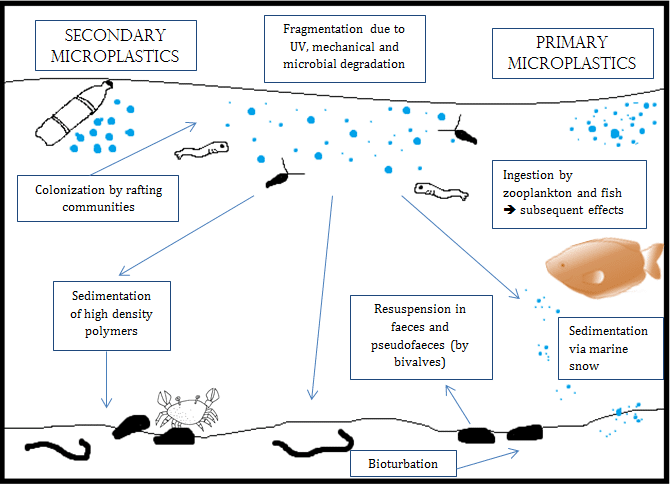
Microplastics In Marine Habitats
The marine environment, including seas, oceans and coastal regions is the largest habitat on our planet. It is also the one in which microplastics have most been studied. MPs have been found in all marine environments. From beaches and the sublittoral zone to the gyres in the centers of the great oceans and down more than 5,500 meters in the depths of the Mariana Trench.
The buzz words “plastic ocean” exist because of the extent of the problem we have created. Any plastic not burned, buried or recycled ends up in the oceans. Currently 10% of all plastics produced enter the oceans. Plastics make up 80–85% of marine litter.
The Ellen MacArthur Foundation, in partnership with the World Economic Forum, published a report in 2017 stating that if current trends continue there will be more plastic than fish in the oceans, by weight, in 2050. The report projects the oceans will contain at least 937 million tons of plastic and but only 895 million tons of fish by 2050.
Is this the world you want your children to live in?
UV light is the main cause of plastic degradation and this is in good supply at the surface of most marine habitats. However, in the open ocean organic biofilms, which develop rapidly on all plastics floating in the oceans, serve to reduce the effect of UV light on plastic pieces. It does this by preventing the light, or some of it, from actually reaching the plastic.
Plastic along the strand-line of marine environments is a major source of plastic degradation because there is ample UV light combined with the abrasive physical processes of wave action. Furthermore occasional drying, along with wave abrasion helps to reduce any biofilms that may form.
Some plastics are denser than seawater, about 54%, these will naturally sink. How much denser they are will determine how much and how quickly they will sink. The remaining plastics are less dense and therefore float and remain forever in the surface waters of the oceans.
Two processes can cause less dense plastics to sink. 1) Colonization of encrusting organisms can change the functional density of any piece of plastic, making it sink more readily. 2) When filter feeding zooplankton consume microplastics much or even all of this can end up in the feces. These are expelled as compact pellets and sink, taking their incorporated microplastics and nanoplastics with them.
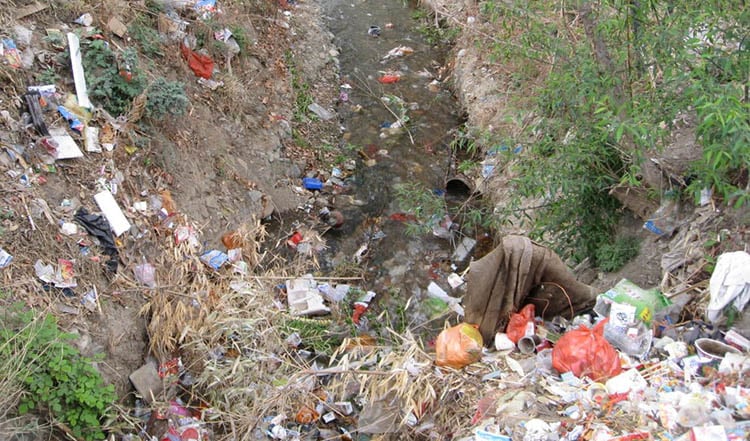
Microplastics In Freshwater Habitats
While freshwater habitats represent a small, and sadly still diminishing, habitat on our planet they are an extremely important one to us humans. Microplastics in fresh water systems are important because:-
- We drink water from fresh water habitats. Microplastics have recently been detected in drinking water as well as in drinking water sources.
- Freshwater is the sources of all agricultural water, meaning plastic contamination of freshwater habitats feeds into microplastic contamination of soils.
- Microplastics in animal drinking water may result in animal flesh becoming contaminated with microplastics.
- Microplastics accumulate and concentrate POPs, which can in turn be passed onto livestock when they drink contaminated water.
- Rivers are considered the greatest source of plastic, micro and otherwise, for the marine environment.
Scientific assessments of the dangers arising from MPs within inland water ecosystems focus on several different topics inculding bioaccumulation, biomagnification, sedimentation and spreading. Recent research shows that MPs density is greater in the waters of lakes than in rivers. However studies of comparable sediments showed no significant difference in the amount MPs present.
North American, European and Asian waters are all known to contain high levels of microplastics. Very few studies have been done to date in Africa and none in South America.
MPs have been found the intestinal tracts in most of the species of fresh water fish so far tested. Also in 11% of fresh water bird species studied as well as in fresh water mussels and shrimps. In addition MPs have been found in both the livers and gills of fresh water organisms. So far no MPs have been recorded from and muscle tissue in fresh water animals. An interesting, and novel, observation has been of case making Caddisflies including MPs in their cases.
In Japan MPs contamination is higher in lakes and rivers located near urban areas. However in other countries such as China contamination is higher in rural areas, while in Australia no difference is detected between different areas. While the actual causes of this variation has not been studied it is likely it stems from variations in the quality of water treatment works.
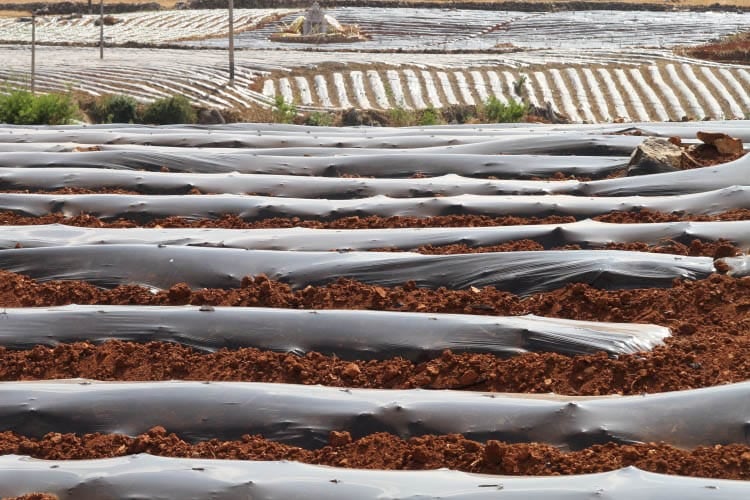
Microplastics In Terrestrial Habitats
Macroplastics in terrestrial environments are the most readily observable form of plastic pollution. This is because that is where we humans live. Such plastics can both degrade the natural beauty and create their own strange beauty.
Microplastics mostly enter the soil through several processes; 1) The break down of macroplastics, either buried or at the surface. 2) As a result fertilization and watering with microplastic contaminated sources. 3) From outside the terretrial system as particles carried by wind and rain.
Microplastics have been recorded from soil samples all across the globe. However their actual effect on the environment has still been very little studied. Furthermore most of this study has been on agricultural environments.
Soil is a dynamic living habitat. It is susceptible to both improvement and degradation. Unfortunately even before the advent of microplastics much of the soil on our planet was in the process of being degraded.
Microplastics in soil can change the structure of soil aggregates. Soil aggregates are the crumbs contributing to soil structure and have a central role in shaping the habitat of soil organisms. Soil organisms in turn create and maintain the soil.
By changing the physical structure of the soil, we change the behaviour of its living inhabitants. In doing this we change the the dynamics of all the nutrient cycles that occur within soils. By changing the nutrient cycles we change the way plants can grow.
Finally microplastics can deliver toxins to the soil, in the same way that they can to the water. By the release of additive chemicals and of other earlier absorbed pollutants.
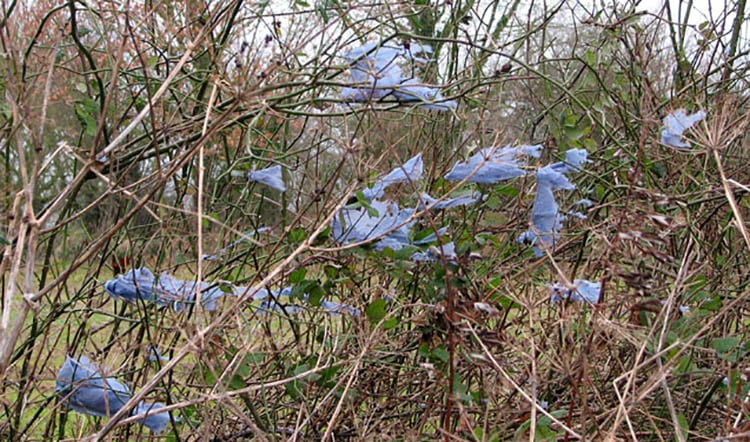
Microplastics In The Air.
Micro and nanoplastics in the air we breath is another extremely new and poorly studied subject. Between 2016 and June 2019 only 13 articles were published on the topic of airborne microplastics.
Microplastics have been observed in atmospheric fallouts in both indoor and outdoor environments. Airborne micro and nanoplastics are collected uing a sampling or vacuum pump, rain sampler, and/or particulate fallout collector.
Airborne microplastics tend to be small and dominated by fibers from synthetic fabrics. While very few studies have been done the evidence to date suggests that the hifgest denisities of airborne micro and nanoplastics can be found indoors.
Furthermore urban habitats seem to contain higher quantities of airborne microplastics than suburban. Finally the air over the ocean appears to contain the least microplastics. Basically the further you get away from cities the less plastic you are breathing.
Airborne microplastics do settle on surfaces. These surfaces include the food on your plate. This means microplastics in the air result in us eating plastic as well as breathing it.
To conclude, air pollution in general has been a hot topic for more than 50 years now. However, it is only recently that scientists have shown that we are breathing plastic as well as all the other poisons our mindless dedication to greed has pumped into the atmosphere.
A Selected Bibliography of Informative Papers
For those who wish to learn more deeply about this emerging and highly significant subject I have assembled a small list of around twenty academic papers to get you started. This was done in September 2020. The articles are ordered from the oldest to the most recent in terms of publication. This initiative report is also worth reading and discussing, New Plastic Economy.
- Jan Alexander et. al. (June 2016) Presence of microplastics and nanoplastics in food, with particular focus on seafood EFSA Panel on Contaminants in the Food Chain (CONTAM).
- Luís Gabriel Antão Barboza et. al. (June 2018) Marine microplastic debris: An emerging issue for food security, food safety and human health
- Ji-Su Kim & Hee-Jee Lee et. al. (October 2018) Global Pattern of Microplastics (MPs) in Commercial Food Grade Salts: Sea Salt as an Indicator of Seawater MP Pollution
- Chung-Sum Lam et. al. (November 2018) A Comprehensive Analysis of Plastics and Microplastic Legislation Worldwide.
- Albert Koelmans et. al. (February 2019) Microplastics in Freshwaters and Drinking Water: Critical Review and Assessment of Data Quality.
- Yudha Gusti Wibowo et. al. (July 2019) Microplastic in Marine Environment and Its Impact
- Philipp Schwabl & Sebastian Köppel et. al. (September 2019) Detection of Various Microplastics in Human Stool
- Oldamur Hollóczki Sascha Gehrke (September 2019) Can Nanoplastics Alter Cell Membranes?
- Oldamur Hollóczki & Sascha Gehrke (November 2019) Nanoplastics can change the secondary structure of proteins
- Robert Hale et. al. (January 2020) A Global Perspective on Microplastics
- Monika Pischetsrieder (January 2020) Determination of microparticles, in particular microplastics in beverages.
- Chen Tu and Qian Zhou et. al. (March 2020) Biofilms of Microplastics.
- Esther Garrido Gamarro, et. al. (March 2020) Microplastics in Fish and Shellfish – A Threat toSeafood Safety?
- M. Sendraa and A. Sacoa et. al. (April 2020) Nanoplastics: From tissue accumulation to cell translocation into Mytilus galloprovincialis hemocytes.
- Róisín Coyle, Gary Hardiman, and Kieran O’Driscoll (May 2020) Microplastics in the marine environment: A review of their sources, distribution processes and uptake into ecosystems.
- Steve Allen and Deonie Allen et. al. (May 2020) Examination of the ocean as a source for atmospheric microplastics.
- Daniel Tang Kuok Ho (June 2020) Effects of Microplastics on Agriculture: A Mini-review.
- Evangelos Danopoulos, Maureen Twiddy and Jeanette M. Rotchell (July 2020) Microplastic contamination of drinking water: A systematic review.
- Alessandra Cera, Giulia Cesarini and Massimiliano Scalici (July 2020) Microplastics in Freshwater: What Is the News from the World?
- Milene Díaz Basantes, Juan A. ConesaJuan and Andrés Fullana (July 2020) Microplastics in Honey, Beer, Milk and Refreshments in Ecuador as Emerging Contaminants.
- Alan Puckowski and Weronika Cwięk et. al. (August 2020) Sorption of pharmaceuticals on the surface of microplastics.
- Nikolaos Evangeliou et. al. (December 2020) Atmospheric transport is a major pathway
of microplastics to remote regions
Image Credits:- Plastic beach by Muntaka Chasant, Microplastic and biological Communities by Mantareina, Microplastic Fibres and Algae by M.Danny25, Ocean Microplastic Jewellry by Dan f edwards – license CC BY-SA 4.0, Nurdles on a beach by maldeseine – license CC BY-SA 3.0, Blue plastic Blue by Evelyn Simak, Polluted Creek by Global Water Forum, – license CC BY-SA 2.0, River Plastic by Provincie Limburg/ Alf Mertens – license CC0 1.0

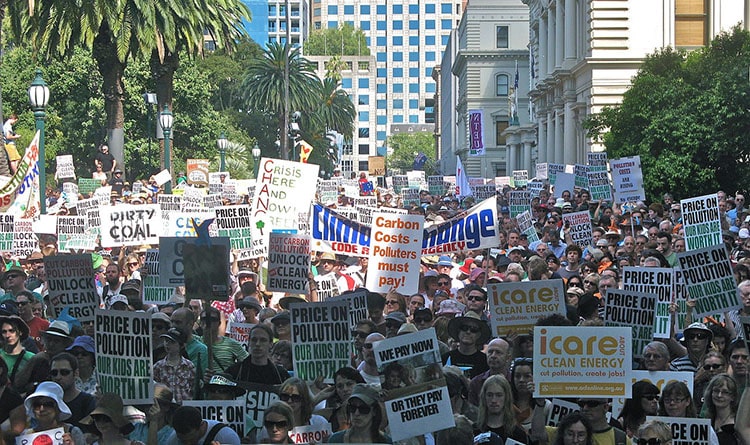
“Plastic pollution in soils poses a major threat to soil health and soil fertility, to food security and human health.
The highest source of microplastic input into the soil is the direct application of sewage sludge for agricultural fertilization”
See –
https://biosolidsbattleblog.blogspot.com/2020/06/recent-research-on-microplastics-sewage.html